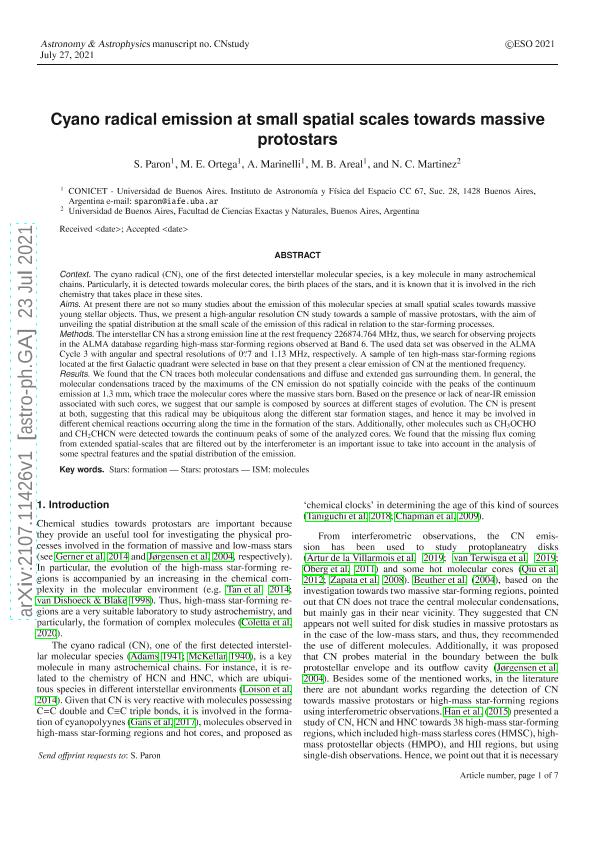Mostrar el registro sencillo del ítem
dc.contributor.author
Paron, Sergio Ariel

dc.contributor.author
Ortega, Martin Eduardo

dc.contributor.author
Marinelli Andino, Alejandro Daniel

dc.contributor.author
Areal, María Belén

dc.contributor.author
Martinez, Naila Constanza

dc.date.available
2022-12-21T14:44:55Z
dc.date.issued
2021-09
dc.identifier.citation
Paron, Sergio Ariel; Ortega, Martin Eduardo; Marinelli Andino, Alejandro Daniel; Areal, María Belén; Martinez, Naila Constanza; Cyano radical emission at small spatial scales towards massive protostars; EDP Sciences; Astronomy and Astrophysics; 653; A77; 9-2021; 1-7
dc.identifier.issn
0004-6361
dc.identifier.uri
http://hdl.handle.net/11336/181994
dc.description.abstract
Context. The cyano radical (CN), one of the first detected interstellar molecular species, is a key molecule in many astrochemical chains. In particular, it is detected towards molecular cores, the birth places of stars, and it is involved in the rich chemistry that takes place at these sites. Aims. At present, there are not many studies on the emission of this molecular species at small spatial scales towards massive young stellar objects. We therefore present a high-angular resolution CN study towards a sample of massive protostars, with the aim of unveiling the spatial distribution at the small scale of the emission of this radical in relation to star-forming processes. Methods. The interstellar CN has a strong emission line at the rest frequency 226 874.764 MHz, thus we searched for observing projects in the Atacama Large Millimeter Array (ALMA) database regarding high-mass star-forming regions observed at Band 6. The used data set was observed in ALMA Cycle 3 with angular and spectral resolutions of 0.′′7 and 1.13 MHz, respectively. A sample of ten high-mass star-forming regions located in the first Galactic quadrant were selected on the basis that they present a clear emission of CN at the mentioned frequency. Results. We found that the CN traces both molecular condensations and the diffuse and extended gas surrounding them. In general, the molecular condensations traced by the maximums of the CN emission do not spatially coincide with the peaks of the continuum emission at 1.3 mm, which trace the molecular cores where massive stars are born. Based on the presence or lack of near-IR emission associated with such cores, we suggest that our sample is composed of sources at different stages of evolution. The CN is present in all sources, suggesting that this radical may be ubiquitous along the different star formation stages, and hence it may be involved in different chemical reactions occurring during the period of star formation. Additionally, other molecules such as CH3OCHO and CH2CHCN were detected towards the continuum peaks of some of the analysed cores. We found that the missing flux coming from extended spatial scales that are filtered out by the interferometer is an important issue to take into account in the analysis of some spectral features and the spatial distribution of the emission.
dc.format
application/pdf
dc.language.iso
eng
dc.publisher
EDP Sciences

dc.rights
info:eu-repo/semantics/openAccess
dc.rights.uri
https://creativecommons.org/licenses/by-nc-sa/2.5/ar/
dc.subject
ISM: MOLECULES
dc.subject
STARS: FORMATION
dc.subject
STARS: PROTOSTARS
dc.subject.classification
Otras Ciencias Naturales y Exactas

dc.subject.classification
Otras Ciencias Naturales y Exactas

dc.subject.classification
CIENCIAS NATURALES Y EXACTAS

dc.title
Cyano radical emission at small spatial scales towards massive protostars
dc.type
info:eu-repo/semantics/article
dc.type
info:ar-repo/semantics/artículo
dc.type
info:eu-repo/semantics/publishedVersion
dc.date.updated
2022-09-23T10:06:45Z
dc.identifier.eissn
1432-0746
dc.journal.volume
653
dc.journal.number
A77
dc.journal.pagination
1-7
dc.journal.pais
Francia

dc.journal.ciudad
París
dc.description.fil
Fil: Paron, Sergio Ariel. Consejo Nacional de Investigaciones Científicas y Técnicas. Oficina de Coordinación Administrativa Ciudad Universitaria. Instituto de Astronomía y Física del Espacio. - Universidad de Buenos Aires. Facultad de Ciencias Exactas y Naturales. Instituto de Astronomía y Física del Espacio; Argentina. Universidad de Buenos Aires. Facultad de Ciencias Exactas y Naturales; Argentina
dc.description.fil
Fil: Ortega, Martin Eduardo. Consejo Nacional de Investigaciones Científicas y Técnicas. Oficina de Coordinación Administrativa Ciudad Universitaria. Instituto de Astronomía y Física del Espacio. - Universidad de Buenos Aires. Facultad de Ciencias Exactas y Naturales. Instituto de Astronomía y Física del Espacio; Argentina. Universidad de Buenos Aires. Facultad de Ciencias Exactas y Naturales; Argentina
dc.description.fil
Fil: Marinelli Andino, Alejandro Daniel. Consejo Nacional de Investigaciones Científicas y Técnicas. Oficina de Coordinación Administrativa Ciudad Universitaria. Instituto de Astronomía y Física del Espacio. - Universidad de Buenos Aires. Facultad de Ciencias Exactas y Naturales. Instituto de Astronomía y Física del Espacio; Argentina. Universidad de Buenos Aires. Facultad de Ciencias Exactas y Naturales; Argentina
dc.description.fil
Fil: Areal, María Belén. Consejo Nacional de Investigaciones Científicas y Técnicas. Oficina de Coordinación Administrativa Ciudad Universitaria. Instituto de Astronomía y Física del Espacio. - Universidad de Buenos Aires. Facultad de Ciencias Exactas y Naturales. Instituto de Astronomía y Física del Espacio; Argentina. Universidad de Buenos Aires. Facultad de Ciencias Exactas y Naturales; Argentina
dc.description.fil
Fil: Martinez, Naila Constanza. Consejo Nacional de Investigaciones Científicas y Técnicas. Oficina de Coordinación Administrativa Ciudad Universitaria. Instituto de Astronomía y Física del Espacio. - Universidad de Buenos Aires. Facultad de Ciencias Exactas y Naturales. Instituto de Astronomía y Física del Espacio; Argentina. Universidad de Buenos Aires. Facultad de Ciencias Exactas y Naturales; Argentina
dc.journal.title
Astronomy and Astrophysics

dc.relation.alternativeid
info:eu-repo/semantics/altIdentifier/arxiv/https://arxiv.org/abs/2107.11426
dc.relation.alternativeid
info:eu-repo/semantics/altIdentifier/url/https://www.aanda.org/articles/aa/full_html/2021/09/aa41424-21/aa41424-21.html
dc.relation.alternativeid
info:eu-repo/semantics/altIdentifier/doi/https://doi.org/10.1051/0004-6361/202141424
Archivos asociados
